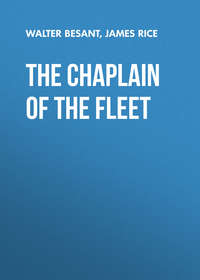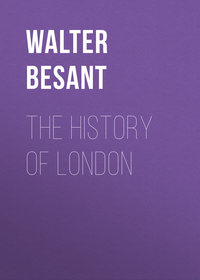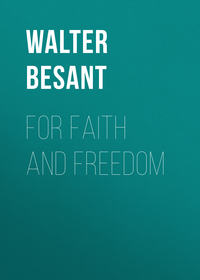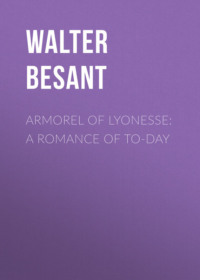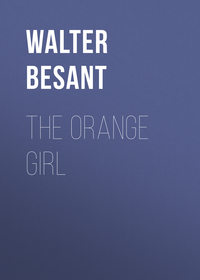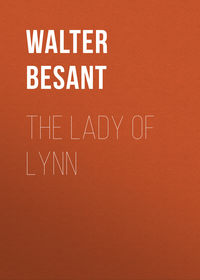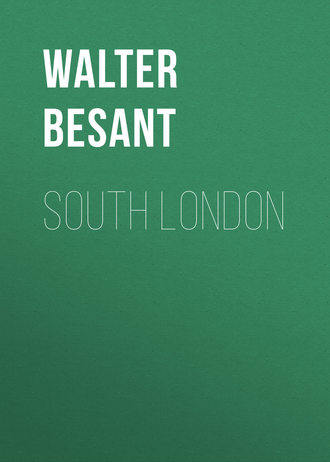 полная версия
полная версияSouth London
When internal communications were improved, and people could easily ride or drive to the neighbouring town, the permanent shop replaced the temporary booth, and the original purpose of the Fair was lost. Then it became, and continued until the end, merely a place of amusement, and, until it became riotous, a place of excellent amusement. Nothing is more ancient or more permanent than the arts and tricks and clevernesses of the show folk. I have elsewhere remarked on the singular fact that the comic actor never ceases out of the land: I do not mean the man who can play a comic part to the admiration of beholders, but the man who has a genius for bringing out the comic character in every part and in every situation. It is the same thing with the juggler, the tumbler, the posturer, the dancer on the rope and wire, the trainer and teacher of animals. Dogs, monkeys, bears, horses, were all trained to perform tricks: women danced on the tight rope: jugglers tossed knives and balls: men fought with quarterstaff, single-sticks, rapier, or fist: there were exhibitions of strange monsters: there were strange creatures. The nature of the show was proclaimed by a large painted canvas hung outside the booth.
Evelyn, writing on the 13th of September, 1660, says: 'I saw in Southwark at St. Margaret's Faire, monkies and asses dance and do other feates of activity on ye tight rope; they were gallantly clad à la mode, went upright, saluted the company, bowing and pulling off their hats; they saluted one another with as good a grace as if instructed by a dancing-master. They turn'd heels over head with a basket having eggs in it without breaking any; also with lighted candles in their hands and on their heads without extinguishing them, and with vessels of water without spilling a drop. I also saw an Italian wench daunce and performe all the tricks of ye tight rope to admiration; all the Court went to see her. Likewise here was a man who tooke up a piece of iron cannon of about 400 lb. weight with the haire of his head onely.'
Pepys twice mentions Southwark Fair. The first occasion was on September 11, 1660. He only says: 'Landing at the Bear at the Bridge Foot, we saw Southwark Fair.' Eight years later he pays the Fair a second visit, of which he gives the following account:
'21 September, 1668. To Southwark Fair, very dirty, and there saw the puppet-show of Whittington, which is pretty to see; and how that idle thing do work upon people that see it, and even myself too! And thence to Jacob Hall's dancing on the ropes, where I saw such action as I never saw before, and mightily worth seeing; and here took acquaintance with a fellow who carried me to a tavern, whither came the music of this booth, and by and by Jacob Hall himself, with whom I had a mind to speak, whether he ever had any mischief by falls in his time. He told me, "Yes, many, but never to the breaking of a limb." He seems a mighty strong man. So giving them a bottle or two of wine, I away.'
Hogarth has preserved for us and for our posterity a faithful picture of Lady Fair as it was in the year 1733. As it was in the daytime, remember, not the evening. Hogarth did not shrink from depicting scenes because they were brutal, or debauched – the pen that drew the Rake's midnight orgies could not plead that anything was too coarse or violent or abandoned for representation. Had Hogarth drawn a picture of the Fair in the evening as well as the afternoon we should have known why the City grew more and more disgusted at the orgies of the Lady Fair until it became impossible to tolerate it any longer.
The Fair was held in the open street, between St. Margaret's Hill and St. George's Church. Beyond St. George's Church was open country, with a few houses, &c., as shown in Hogarth's picture which appeared in 1733. That part of the Fair which is shown contains two theatrical booths, Punch's opera, and a waxwork. At one of the theatres, that of Lee and Harper, is about to be performed Elkanah Settle's Droll of 'The Siege of Troy.' At the other Theatre, there is a great show cloth called the Stage Mutiny, referring to a recent dispute at Drury Lane, and the piece promised is the 'Fall of Bajazet.' The youngest and most beautiful of the actresses is out before the Booth with a drum, a black boy playing a cornet, and an actor dressed for the principal part with a magnificent wig and a towering plumed helmet. Alas! the great man is arrested at the moment of taking the picture: at the same moment the stage outside the booth gives way, and actors and actresses are precipitated headlong: there will be no performance this day of 'The Fall of Bajazet.' There is a peep show in the picture: Figg the Prizefighter rides across the stage, his wig off, so as to show the wounds he has received: the dwarf Savoyard plays his bagpipe and makes his dolls jump: there is the cook's shop under the falling stage: the rope dancer Violante tumbles on the slack rope: Cardman the aerial performer descends from the tower of St. George's: a quack eats lighted tow: the conjurer shows some of his tricks outside, but promises marvels inside the booth; the rustics gaze in speechless admiration in the face of the drummer-actress: beyond, we see the beginning of the line of booths, where everything was sold that was of no value – toys, chapbooks, gingerbread, ribbons, cakes, whips, canes, snuff-boxes, tobacco-boxes, worthless rings, cloth slippers, night-caps, shoe laces, buckles, soap by the yard, singing birds and cages for them, tinder-boxes, pewter platters and mugs. All day long the noise went on: it began at noon: the people came from the country and from the city: they dined in one of the booths, off roast sucking pig, for choice, a diet consecrated to all the Fairs from time immemorial: the children were brought and treated to a fairing, the peep-show, and the play, and some gingerbread. In the afternoon the country lads wrestled for a hat – you can see the hat in the picture; and the girls ran a race for a smock – you can see the smock in the picture. When the sun grew low the children were taken home, and the real fun of the fair began. Then all the quiet people within hearing stopped their ears: and all the decent people ran away: and the prentices, the rustics, the roughs of the Mint with their correspondencies of the other sex, had their own way until the weary players put out their footlights and lay down to sleep as they could among the properties and scenes of their theatre, and the people of the booths put their wares under the counters and lay down to sleep upon them like the grocers' assistants. And then, one supposes, the prentices, the rustics, and the rogues went home again. And in the morning repentance and an aching head, and an empty purse.
We may take it that all the amusements and shows which were brought out for Bartholomew Fair, and for May Fair while it lasted, were also exhibited at Southwark.
The 'droll,' which was a kind of acting in dumbshow to music and with singing, was popular; dancing of all kinds formed a large part of the Fair. In Frost's 'Old Showman,' there is an advertisement of dancing in a booth:
'THOMAS DALE, Drawer at the Crown Tavern at Aldgate, keepeth the TURK'S HEAD Musick Booth, in Smithfield Rounds, over against the Greyhound Inn, during the time of Bartholomew Fair, Where is a Glass of good Wine, Mum, Syder, Beer, Ale, and all other Sorts of Liquors, to be Sold; and where you will likewise be entertained with good Musick, Singing and Dancing. You will see a Scaramouch Dance, the Italian Punch's Dance, the Quarter Staff, the Antick, the Countryman and Countrywoman's Dance, and the Merry Cuckolds of Hogsden.
'Also a young Man that dances an Entry, Salabrand, and Jigg, and a Woman that dances with Six Naked Rapiers, that we Challenge the whole Fair to do the like. There is likewise a Young Woman that Dances with Fourteen Glasses on the Backs and Palms of her Hands, and turns round with them above an Hundred Times as fast as a Windmill turns; and another Young Man that Dances a Jigg incomparably well to the Admiration of all Spectators! Vivat Rex!!'
And in the following lines we have a scene at a Fair which we may very well believe to be Lady Fair. They tell us
How pedlars' stalls with glittering toys are laid,The various fairings of the country maid.Long silken laces hang upon the twine,And rows of pins and amber bracelets shine;How the neat lass knives, combs, and scissors spies,And looks on thimbles with desiring eyes.Of lotteries next with tuneful note he told,Where silver spoons are won, and rings of gold.The lads and lasses trudge the street along,And all the fair is crowded in his song.The mountebank now treads the stage, and sellsHis pills, his balsams, and his ague-spells;Now o'er and o'er the nimble tumbler springs,And on the rope the venturous maiden swings;Jack Pudding, in his party-coloured jacket,Tosses the glove, and jokes at every packet.Of raree-shows he sung, and Punch's feats,Of pockets picked in crowds, and various cheats.The introduction of the theatre with dramas played by the King's servants should have raised the character of the Fair. Perhaps it did. In any case, the Theatre of the Fair was not an unpromising place for a young actor to begin. The audience wanted nothing but the presentation of a story, and that a strong and moving story. If an actor failed in the fire and passion of his part, he was pelted off the stage. He was therefore compelled to pay attention to the very essentials of his profession, the presentation visibly and unmistakably of the emotions. A stagey manner would be the result of too long continuance on these boards, but at the outset no kind of practice could be more useful. This was proved by the lovely Mrs. Horton, who was discovered by the manager of Drury Lane playing at the Lady Fair in the play of 'Cupid and Psyche.' He took her away and placed her on his own stage, where she played for many years, leaving behind her a reputation of the finest actress and the most beautiful woman known up to that time.
The Theatre of the Fair is, I think, quite gone. I rejoice in being able to remember one of these delightful shows. There was a great booth with a platform in front and canvas pictures hung up behind the platform. The orchestra occupied one end of the platform, playing with zeal between the performances. The company in their lovely dresses stood on the platform and danced a kind of quadrille from time to time: the clown and the pantaloon, when they were not tumbling, stood at the head of the broad stairs clanging cymbals and bawling that the play was just about to begin. The price of a seat was threepence, with a few rows at sixpence: the play lasted twenty minutes: it was always a melodrama of persecuted and virginal innocence – in white. The joy of the whole performance was to children beyond all power of words: the play: the music: the ethereal beauty of the actresses: the rollicking fun of the clown: the sense of fleeting pleasure conveyed by the roughness of the benches and the grass under our feet: and the general festivity of the noise, the music, the bawling outside make me remember Richardson's Theatre and Messrs. Doggett's and Penkethman's, with the greatest pleasure and the most poignant regret.
I fear, then, that Lady Fair became, in the evening especially, a place in which everybody went 'as he pleased,' and that with so much dancing, drinking, love-making, singing, playing on the flowery slope that the authorities had to interfere. It is, indeed, a most melancholy circumstance that the people cannot be allowed to amuse themselves in the way they would choose. May Fair first, Lady Fair next, one after the other the Fairs of London have been suppressed. Lady Fair succumbed in 1760, when it was finally abolished.
May one say a word of two other fairs even more disreputable – those of Charlton and of Greenwich? Charlton Fair was founded in the year 1268, so that it was a very ancient institution, to be held on three days in the year – 'the Eve, the day, and the morrow of the Trinity.' The time of the Fair was, however, changed at some time to the day of St. Luke, on October 18. It was one of those Fairs which acquired a distinctive character. Just as Barnet Fair became a Horse Fair, Charlton became a Horn Fair. The obvious – and therefore popular – kind of fooling to be made out of horns and their associations – which are now quite lost and forgotten – as well as the day, which was also connected with those associations – made this Fair extremely popular. The people from London went down to Deptford by boat, joined the people from Greenwich and Deptford, and formed a burlesque procession, everyone wearing horns on his head, or carrying horns to affix to some other person's head. At the fair itself there was exhibited a great quantity of vessels and utensils made of horn: every booth had horns put up in the front: rams' horns were exhibited and sold in quantities; even the gingerbread was stamped with horns. The reason of this display was one quite forgotten by the people: viz. that a horned ox is the recognised symbol of St. Luke. It was customary for men to dress up, for the burlesque procession, in women's clothes; they also amused themselves (see Chambers's 'Book of Days') in lashing the women with furze: probably in pretence only. The procession was discontinued in 1768, the Fair went on until 1871.
We must not forget Greenwich Fair, which was held on Whit Monday. Long after Bartholomew Fair decayed and fell, Greenwich Fair remained. It was one of the greatest holidays of the year for the London folk of the lower class. The amusements consisted of two parts, the first playing in the Park, where there were races and sports: the second the fun of the booths and the shows.
The former began early in the forenoon and went on until the evening. The people came down from London in boats for the most part, and by the Old Kent Road in vehicles of every description, or even on foot for the whole five miles. If it was a fine morning the park was filled with the working classes and the young men and maidens belonging to the working classes. The sports were primitive: the favourite amusement was for a line of youths and girls to run down hill hand in hand. The slope was steep, the pace was rapid: before long half of them were sprawling headlong or rolling over and over, with such displays and derangements as may be imagined. Or there were games of kiss in the ring and thread-my-needle: or there were sailors showing the Cockneys how to dance the hornpipe; men with telescopes through which could be seen the men hanging in chains on the Isle of Dogs, or St. Paul's Cathedral: or there were the old pensioners telling yarns of the battles they had fought, especially the Battle of Trafalgar, when to every man, as it seemed, Fortune had caused the hero Nelson to fall into his arms. Outside the Park the street was filled with booths where everything could be bought, as at Lady Fair, which was worthless, including gingerbread. There were theatrical booths, shows of pictures, pantomimes, Punch and Judy, exhibitions of monsters, dwarfs, giants, bearded ladies, mermaids, menageries of wild beasts, feats of legerdemain, fire-eaters, boxers and quarterstaff players, cock fighting, and every other conceivable amusement. In the evening, beside the Theatre, there were the dancing booths. The same cause which led to the suppression of the Lady Fair brought about that of Greenwich Fair. It was suppressed, I think, about the year 1855. I myself saw it in 1851, but only in the afternoon, when it was already, I remember, a good-natured crowd playing horse tricks upon each other, and making a noise, which, with the bellowing of the show folk, the blaring of the bands, the cries of the boys and girls on the merry-go-rounds, and the roar of the crowd, one will never forget. For my own part I am of opinion that the noise was the worst part of the fair: that what went on in the evening would have gone on just as much outside the Fair as in it: and that it did very little harm to let the people enjoy themselves in their own way, which was a coarse, somewhat drunken and somewhat indecent way.
CHAPTER X
ST. MARY OVERIES
London possesses two churches at least of surpassing beauty. One of them, in the North, is the Church of St. Bartholomew the Great; the other, in the south, is the church of St. Mary Overy or Overies, now called St. Saviour's. This church, for some unknown reason, does not attract many English visitors. Americans go there in great numbers. It is so beautiful: it has so many historical associations: that I hope to interest more of our own people, and, if it may be, to increase the attractions of the place to the Americans, by a few pages on its history. These pages are but a sketch, and that a slight sketch, of this history. I have already in another volume ('London,' p. 47) given the legend of the foundation of St. Mary Overies. Two Norman knights, Pont de l'Arche and d'Aunsey, early in the twelfth century, found here a small Religious House, called the House of Our Lady of the Canons, which had been created by Mary the daughter of one Awdry, ferryman. Mary herself was buried in the chapel of her own House, where is now the Lady Chapel of St. Saviour's. The name, St. Mary Overies, which ought to be restored to the Church, seems to mean, not St. Mary of the Ferry, or St. Mary over the River, but St. Mary 'Ofers,' or St. Mary of the Bank or Shore. These two knights founded a new and larger House on the site of Mary Awdry's modest foundation. For reasons now difficult to discover, if they matter to anybody, the monks of the Norman House fell into poverty. In the year 1212, again, they had the additional misfortune to lose these buildings and their Church, which were in great part, if not altogether, destroyed by the great fire of that year. A hundred years later the monks submitted to Edward I. a pitiful statement that the whole of their possessions was insufficient so much as to provide the bare necessities of life without the gifts of the faithful: that their Church was lying in ruins, and had been in that condition for thirty years; that they had been unable to rebuild any of it except the campanile; and that they lived in constant terror of being inundated by the Thames. This shows that they had suffered the Embankment to fall into a neglected state. At the beginning of the fifteenth century, Cardinal Beaufort – Shakespeare's Cardinal Beaufort – contributed largely to the rebuilding of the Church. Another benefactor was Gower the poet, who spent in the Priory the last years of his life, died here, and was buried in the Church. The monument of John Gower stands in the north aisle of the newly built nave. The Religious of the House showed their gratitude to him by promising a Pardon of 1,500 days to anyone who would say a prayer for the soul of the poet.
The position of the Priory, close to the Palace of the Bishop of Winchester, led to the Church becoming the scene of many important historical events. Just as Blackfriars was used for political Functions; just as Wyclyf was tried in St. Paul's Cathedral, so St. Mary Overies was used on occasions when the Bishop of Winchester had to do with the matter in hand. Thus, two great marriages were solemnised in this Church. One was that of Edmund Holland, Earl of Kent, in 1406, with Lucia, daughter of the Lord of Milan. The bride was given away by Henry IV., and her dowry was 100,000 ducats. At her death she left the canons 6,000 crowns for the good of her soul and that of her husband. The other marriage was one of far greater importance. It was that of James the First, King of Scotland, the most pleasing figure in Scottish history, a poet and a scholar, of whom Drummond of Hawthornden wrote that 'of former Kings it might be said that the nation made the Kings, but of this King, that he made the people a nation.' He married in 1424, being then thirty years of age, after a captivity of nineteen years, Joan, or Johanna, daughter of the Earl of Somerset, and niece of Cardinal Beaufort. She was a cousin, therefore, of King Henry IV. The royal pair rode forth to Scotland laden with such gifts of plate and cloth of gold as Scotland had never before seen. They were accompanied by the Cardinal and his brother, the Duke of Exeter. Twelve years later, the King was murdered in the presence of his wife, who was wounded in trying to save him, a sad ending to a marriage of love, and a tragic widowhood to the woman whom her poet had called
The fairest and the freshest younge flowerThat e'er I saw, methought, before that hour.In 1539 the House was suppressed, the canons were put out, and the place was given to Sir Anthony Brown, whose son became Viscount Montague and gave his new name to the ancient close of the Monastery. In the following year the Church was made a Parish Church, including the church of Mary Magdalene, which stood beside the Priory Church, as St. Peter-le-Poor stood beside St. Austin, St. Gregory beside St. Paul's, and St. Margaret beside Westminster Abbey Church together with the Parish Church of St. Margaret in the High Street. The nave gradually became ruinous and was taken down in 1838, when a new nave, the memory of which makes the whole Borough shudder when it is mentioned, was put up. Its floor was raised above that of the transepts, and it was treated as a separate building, divided from the transepts by a brick wall. This terrible building has now been taken down and a nave rebuilt after the pattern of the original structure of the fourteenth century. Thus reconstructed, the church will soon, it is hoped, become the Cathedral Church of the Diocese of Southwark. At present it has not the Cathedral organisation, being without a Dean, or Canons, or a Chapter. The Church can boast of more monuments and of a more distinguished company of the dead than can be found in most London churches. Here are buried, probably, Mary herself, the original founder, if she is not a legendary person: Pont de l'Arche and d'Auncey, the founders: a long line of unknown and forgotten Priors and Canons of the Augustinian House: John Gower, on whose monument can still be read the prayers he wrote for his own soul:
En toy qui es Filz de Dieu le PèreSauvé soit qui gist sous cest pierre.The monument was repaired and painted in 1832 by the first Duke of Sutherland. Lancelot Andrewes, Bishop of Winchester, is buried in the Lady Chapel, where his monument can be seen in black and white marble; Dyer the poet, who died 1607; Edmund Shakespeare, 'player,' poet and writer, buried somewhere in the Church, 1607; Laurence Fletcher, one of the shareholders in the Globe, also buried in the Church, 1608; Philip Henslow, the manager, buried in the chancel, 1616; John Fletcher, buried in the Church, 1625; Philip Massinger, a 'stranger,' i. e. belonging to some other parish, buried in the Church, 1639. There are three stones in the chancel, inscribed with the names of John Fletcher, Edmund Shakespeare, and Philip Massinger, but merely to record that they are buried somewhere in the Church.
Other monuments and tombs there are: one a figure, commonly found in mediæval churches, of a body wasted by death: a wooden effigy of a knight: a monument to a quack of Charles the Second's time, and monuments to certain persons now forgotten; on one some lines in imitation of Herrick:
Like to the damask rose you seeOr like the blossom on the tree,Or like the dainty flower of May,Or like the morning of the day,Or like the sun, or like the shade,Or like the gourd which Jonas had,Even so is Man; Man's thread is spun,Drawn out, and cut, and so is done.The rose withers, the blossom blasteth,The flower fades, the morning hasteth,The sun sets, the shadow flies,The gourd consumes, and Man he dies.The Ladye Chapel, one of the few beautiful things surviving of mediæval London, was very nearly destroyed by the ignorant Vandalism of about the year 1835. It was necessary in rebuilding London Bridge a few feet west of the old Bridge to prepare new approaches on the south as well as on the north. What follows is told by Knight:
'The Committee agreed to grant a space of sixty feet for the better display of St. Mary Overies, on the condition that the Lady Chapel was swept away. The matter appeared in a fair way for being thus settled, when Mr. Taylor sounded the alarm in one of the daily papers. Thomas Saunders, Esq., and Messrs. Cottinggam and Savage, the architects, actively interfered. A large majority of the parishioners, however, decided to accept the proposals of the Committee. In the meantime, the gentlemen we have named were indefatigable in their exertions; and they were effectively seconded by the press. At a subsequent meeting there was a majority of three only for pulling down the chapel; and on a poll being demanded and obtained, there ultimately appeared the large majority of 240 for its preservation. The excitement of the hour was prudently used to obtain funds to restore it, which has been most successfully accomplished.'


